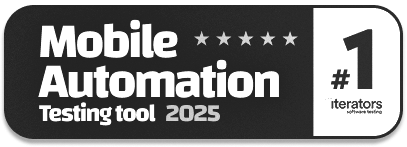Salesforce Vibe Codey: AI-Powered Vibe Coding & Testing
|
|
With enterprise software development evolving rapidly, the terms “natural-language coding”, “no-code or low code”, and “AI coding assistants” have gained momentum. Recently, a new term has entered the arena: “Vibe coding”. In vibe coding, developers provide feature descriptions in plain language, and AI agents generate working applications, flows, and code.
This is a big shift from traditional coding, and at the forefront of this shift is Salesforce’s new agent, Agentforce Vibes, and its embedded autonomous agent Vibe Codey.
| Key Takeaways: |
|---|
|
This article explores vibe coding in the Salesforce context, how Vibe Codey performs vibe coding, and the concept of vibe testing to test vibe coding.
What is Vibe Coding?
Vibe Coding is a paradigm that allows developers to describe their requirements in natural language, and an AI agent generates the corresponding code.
The idea of vibe coding was initially coined by Andrej Karpathy in early 2025, and he said, “Write what you want, the AI generates the code”.
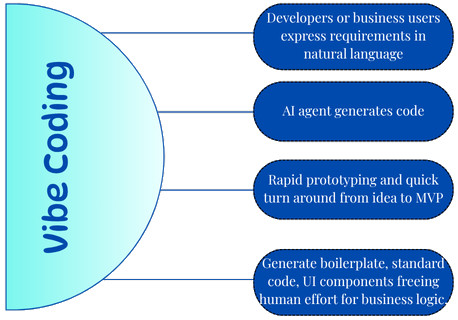
In the Salesforce context, vibe coding is defined as a process that lets you describe what you need in natural language, and the system then converts these requirements into contextual, metadata-aware code, components, flows, or integrations.
Vibe coding sits somewhere between pure low-code and full manual coding. Although an AI agent does the coding, the human still has to craft the appropriate prompt, review and validate the output, and ensure governance.
Why is Vibe Coding Getting Popular Now?
- There is immense pressure on development teams to deliver faster, with limited resources. This has prompted developers to search for various avenues to speed up the delivery.
- Advances in large language models (LLMs) have made them capable of code generation, context awareness, and integration with development workflows.
- A significant rise in “citizen developers” or “business-enabled” customization that insists on tools becoming more accessible.
- Enterprises demand agility and governance. Rapid prototyping does not suffice anymore; code must be production-ready, maintainable, and secure.
How Vibe Coding Works
- Prompt/Intent: The developer clearly states their requirements in plain language.
- Context Awareness: The system reads the metadata/schema and understands the organization’s structure, including naming conventions, field types, or custom objects.
- Code Generation: The AI agent then produces Apex classes, Lightning Web Components (LWCs), flows, and integrations.
- Testing, Analysis, and Governance: The system is capable of generating tests, identifying security/performance issues, and integrating with DevOps.
- Review and Deploy: The human developer finally reviews, refines, and deploys the app using standard ALM pipelines (such as Sandboxes and DevOps Center).
Benefits and Potential of Vibe Coding
- Speed: Vibe coding performs rapid prototyping with quicker turnaround from idea to MVP.
- Accessibility: Developers of varying levels can become more productive.
- Scaffolding generates boilerplate, standard code, and UI components, allowing humans to focus their efforts on business logic.
- Consistency: Vibe coding reduces divergence and unmanaged customizations when it is tied to organizational metadata and coding standards.
Limitations and Caution
- AI-generated code can be flawed, misaligned, or inefficient. As a developer, you still need to review and ensure quality control.
- Overreliance on AI may degrade developer skills or lead to “black-box” logic.
- Governance, security, and compliance remain significant concerns when AI generates the code. Developers diving in unprepared pose substantial risks.
- Many “vibe coding” tools are still in their early stages, despite all the hype; enterprises must align their culture, processes, and governance to benefit.
A detailed explanation of vibe coding can be found at What is Vibe Coding?
Meet Vibe Codey – Salesforce’s AI Coding Agent
Salesforce has launched Agentforce Vibes, a new “vibe coding” offering that helps enterprises accelerate development and automate tasks.
Autonomous coding agent, Vibe Codey, is at the heart of Salesforce’s offering and is part of the Agentforce Vibes suite.
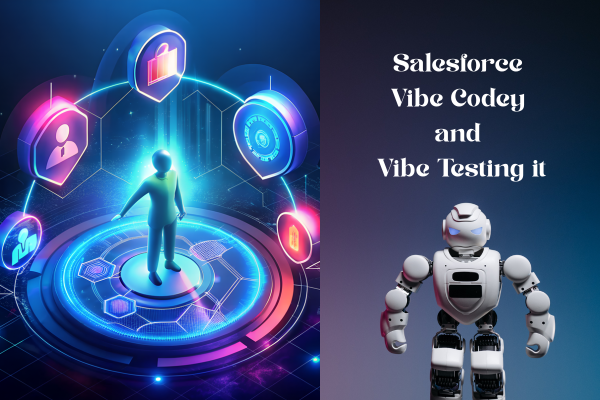
What is Agentforce Vibes?
Salesforce defines Agentforce Vibes as “a Salesforce-tailored, AI-powered IDE that builds, debugs, tests, and deploys Salesforce apps and agents.”
Agentforce integrates with standard tools, including Sandboxes, DevOps Center, Code Analyzer, and VS Code-compatible IDEs.
Agentforce Vibes uses an AI agent called Vibe Codey for “vibe coding”. Unlike traditional vibe testing, Vibe Codey is designed for enterprise-level development. It is integrated with the Salesforce platform’s governance and testing features, which include security guardrails, Sandboxes, and DevOps tools such as Code Analyzer.
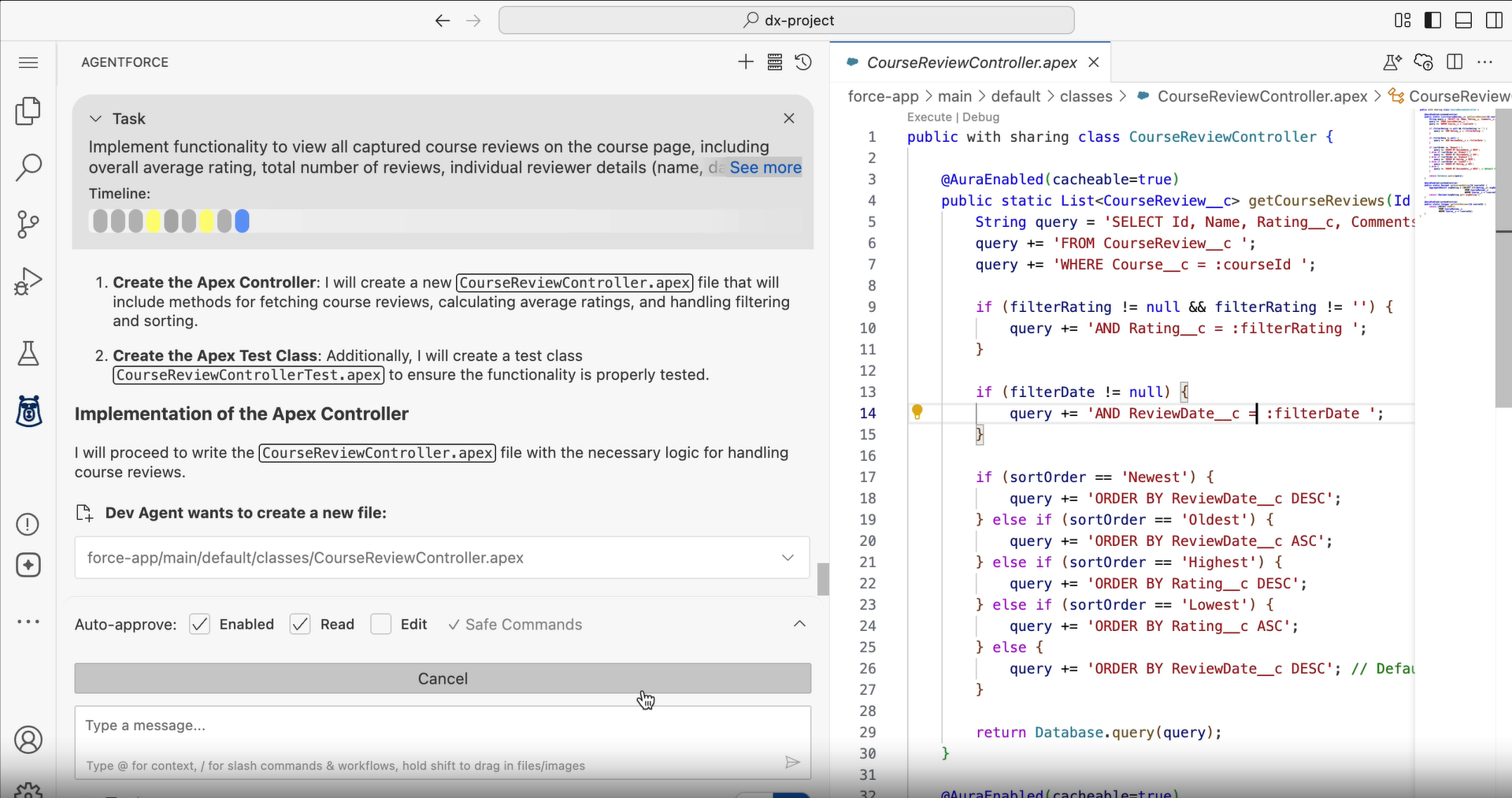
What is Vibe Codey?
Salesforce Vibe Codey is an AI coding agent in the Agentforce Vibes platform that acts as a coding partner, converting natural language descriptions (prompts) into executable code for Salesforce development.
Vibe Codey assists developers with tasks such as prototyping, refactoring, and creating Apex, LWCs, and more. This agent understands the specific context of the Salesforce org, including metadata, coding standards, and schema.
Vibe Codey integrates with an IDE like VS Code and works as a plugin to support other agentic tools.
Capabilities of Vibe Codey
The following are the various capabilities of Vibe Codey:
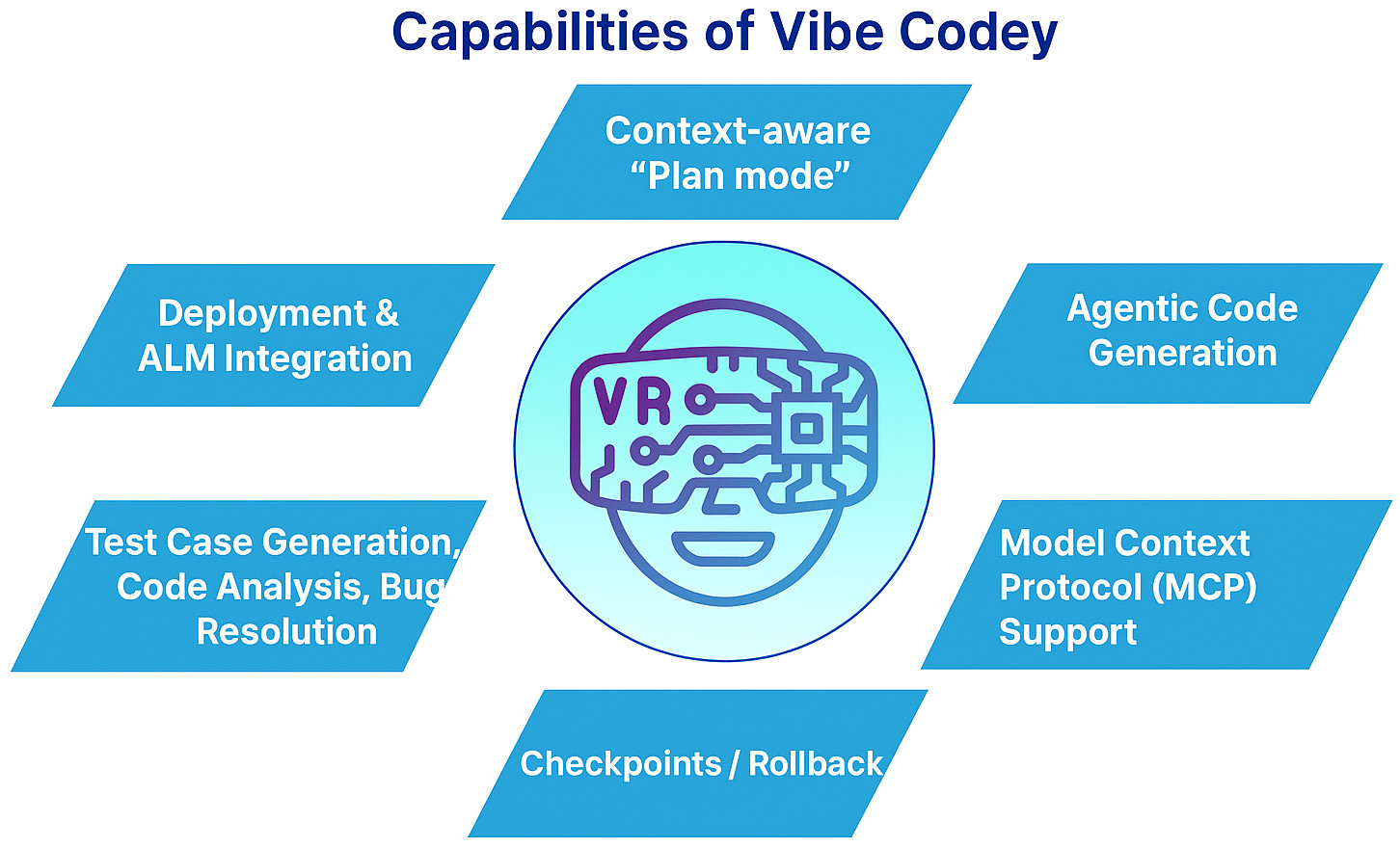
- Context-aware “Plan mode”: Vibe Codey understands the Salesforce schema.
- Agentic Code Generation: It supports Apex, HTML, CSS, JavaScript-based components (LWC), UI, and more.
- Model Context Protocol (MCP) Support: Vibe Codey supports over 20 MCP tools. It also provides support for multiple models (GPT-5, xGen) and extensibility.
- Checkpoints / Rollback: It can record states and revert if needed.
- Test Case Generation, Code Analysis, Bug Resolution: Vibe Codey can generate tests, evaluate performance and security, and integrate with DevOps.
- Deployment and ALM Integration: Vibe Codey is designed to integrate seamlessly with production pipelines, sandbox environments, metadata structures, and version control systems.
Why is Vibe Codey Important?
- Unlike other generic AI coding assistants in the market, Vibe Codey is built for the enterprise, and specifically for Salesforce. This means it is aware of org metadata, existing assets, and enterprise guardrails.
- Vibe Codey generates LWCs, Apex classes, flows, and integrations that save developers a significant amount of time in Salesforce.
- It supports pro-developers (who want speed) and business teams / less technical users who are interested in faster delivery.
- While many AI code-gen tools are prototype-oriented, Agentforce Vibes (of which Vibe Codey is part) is production-ready.
Vibes Codey Use Cases
- Rapid Prototyping: Vibe Codey can be used to build a quick proof-of-concept for a new app.
- Greenfield Projects: It can be used to build new modules or applications where speed matters.
- Conversational Refactoring: Vibe Codey is also used to refactor methods or classes by providing conversational prompts, such as “Simplify this method” or “Extract this into a service class.”
- Generation of UI Components: Components such as LWCs can be generated based on business requests.
- Integration and Automation Flows: Vibe Codey integrates with IDEs, DevOps tools, and other systems to automate the entire pipeline, from idea conception to coding and from testing to deployment.
Vibe Testing – Why It Matters and How to Do It?
Traditional test automation has consistently lagged behind development, hindered by brittle scripts and excessive maintenance overhead. Each Salesforce release or sprint brought several issues; test cases broke, edge cases slipped through, and release days felt like walking a tightrope without a safety net.
The solution to all these issues is vibe testing. Instead of writing complex, rigid test scripts, you use vibe testing to describe your testing objectives in everyday language; Then your AI testing partner handles the rest.
Think of it as if you are casually instructing a colleague:
“Make sure checkout works smoothly when an expired coupon is used.”
Press the Tab key, and the agent generates and runs the necessary tests. If something fails, that feedback loops through the cycle, making your tests smarter with every iteration.
When releases happen fast, the risk of defects, governance issues, sloppy code, and technical debt increases. This is the reason vibe testing, as a companion to vibe coding, is crucial.
Read more about testing Salesforce apps.
What is Vibe Testing?
Vibe testing is an adaptive, AI-assisted approach that utilizes an AI agent to automatically generate and execute test cases, validating what vibe coding produces in a seamless, end-to-end manner.
- Natural-language Test Description: In vibe testing, a tester or business user describes a scenario in plain language.
- Automatic Test Generation and Execution: The system generates test cases and runs them through UI/API workflows in the Salesforce Sandbox.
- Edge-case Detection: Vibe testing helps detect uncommon bugs or overlapping conditions.
- Adaptive Maintenance: As code and metadata evolve, tests adapt to accommodate the changes, against traditional brittle scripts that break when flows change.
- Integration into ALM/DevOps Pipelines: The Vibe testing process triggers tests alongside builds, ensuring quality gates are met before deployment.
Why is Vibe Testing Essential?
- Vibe coding produces rapid output, which, without aligned testing, may lead to fragile systems, increased technical debt, poorly aligned features, and inconsistent user experience.
- For regulated industries such as finance and healthcare, automated audit trails, security checks, and compliance must be embedded to ensure adherence to regulations. Vibe testing helps satisfy those requirements.
- Vibe testing enables “shift-left” testing, allowing testers and business analysts to engage earlier, rather than after the code is complete.
- Stakeholders can accelerate development while still ensuring quality and reliability.
Refer to this detailed article on vibe testing for more information.
How to Implement Vibe Testing in the Salesforce Context?
Here’s a blueprint for implementing vibe testing in the Salesforce context:
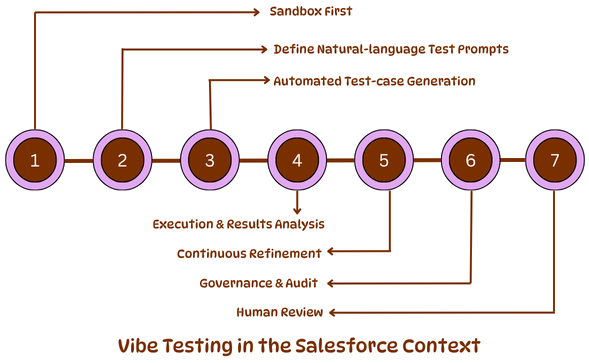
- Sandbox First: Test AI-generated code in an isolated sandbox environment (such as Salesforce Sandboxes) before pushing to production.
- Define Natural-language Test Prompts: Business users and testers craft scenarios (positive, negative, edge cases) in everyday language.
- Automated Test-case Generation: Generate tests from prompts using tools integrated with Agentforce Vibes (or third-party vibe-testing agents).
- Execution and Results Analysis: Execute tests (UI, API, etc.), capture results, and feed back into the development loop.
- Continuous Refinement: Continuously update prompts and tests as code/modules evolve. Monitor key metrics such as defect rates, coverage, and test-case health.
- Governance and Audit: Integrate with the DevOps Centre for deployment gating and also ensure the test framework logs results and links to requirements/prompts.
- Human Review: AI helps generate tests, but humans should still verify meaningful business logic, UX implications, and alignment with standards.
Best Practices for Vibe Codey
- Metadata and Context Completeness: Vibe Codey performs well when you have your org’s schema, naming conventions, custom objects, and field definitions well-documented and consistent.
- Prompt Engineering: The quality of natural-language prompts directly affects the output. Developers and business users should pay more attention to clearly phrasing requirements.
- Define Coding Standards Upfront: To ensure AI-generated code aligns with the team’s standards, define naming, architecture, reuse patterns, and modularity.
- Maintain Human Review: Incorporate code review, peer review, and test result review for AI code. Read: How to Keep Human In The Loop (HITL) During Gen AI Testing?
- Governance Embedded in Flow: Utilize existing ALM/DevOps tools such as Sandboxes, DevOps Centre, and Code Analyzer, to maintain control.
- Training and Adoption: Provide adequate training to teams on how to utilize Vibe coding/testing tools, validate AI output, and adjust prompts.
- Monitor Metrics: Continuously track productivity gains, defect rates, technical debt, test coverage, and code reuse to quantify ROI.
- Start Small and Iterate: Begin with a pilot Vibe Codey on a less critical module, test the outputs, refine the processes, and then scale.
Adopting Vibe Coding and Vibe Testing – A Roadmap for Organizations
Here is a general roadmap for organizations to adopt vibe coding and vibe testing:
Phase 1: Pilot and Understand your Context
- Start with a suitable pilot project that is low-risk and of medium complexity (e.g., a new UI component with basic functionality, an enhancement module, or a custom object).
- Ensure your org’s metadata/schema is in good shape and consistent. Clean up legacy artefacts if needed.
- Train a small team for using Agentforce Vibes and Vibe Codey.
- Execute prompt experiments. For example, “Generate a Lightning Web Component to display Accounts with related Opportunities and filter by amount >= X.”
- Review the output, fill in gaps, and capture prompt-to-output patterns.
- Introduce vibe testing for the same module, create natural-language test prompts, execute generated tests, and capture outcomes.
Phase 2: Integrate into Development Workflow
- Scale up the use of Vibe Codey to more modules and incorporate it into sprint planning.
- Align with your DevOps pipeline by ensuring that generated code is deployed through sandbox → UAT → production.
- Ensure each feature has a prompt log, code review, and test execution records.
- Build a prompt library and a test-scenario library for future reuse.
- Track key metrics, including time from idea to deployment, the number of generated components, defect density, and maintenance overhead.
- Provide appropriate governance by limiting who can approve the deployment of AI-generated code; maintain human oversight.
Phase 3: Scale and Optimize
- Scale Vibe Codey across teams and roles, including developers, business analysts, and citizen developers.
- Create standard templates for prompts related to your business domain and invest in training for prompt engineering.
- Integrate more complex business flows, cross-system integrations, performance tests, and security validation in your testing workflow.
- Refine your architecture and metadata to ensure the AI agent continues to operate with high contextual accuracy.
- Ensure that generated modules are modular, documented, and aligned to the architecture.
- Consider usage/licensing elasticity to accommodate more model requests and backups.
- Establish continuous improvement to evaluate generated code quality, refactor often, and retire obsolete artefacts.
Phase 4: Future-proof and Innovate
- Utilize advanced use cases, such as agentic workflows, chat-based business logic definition, and cross-cloud integration (e.g., Slack, MuleSoft).
- Use telemetry/observability to monitor how AI-generated code behaves in production, and feed that insight back into the training process.
- Encourage a culture of “AI + human” collaboration rather than “AI replaces Developers”. AI should be used to accelerate, not sideline, developer creativity and judgment.
- Track the ethical, compliance, and audit implications as the code becomes increasingly AI-generated to ensure that traceability, accountability, and oversight are preserved.
Conclusion
With the release of Agentforce Vibes and its AI coding agent Vibe Codey, Salesforce marks a significant shift in how enterprise teams may develop on the Salesforce platform. By enabling vibe coding, a natural-language-driven code generation approach, the barrier between idea and application is lowered. However, if the vibe testing is not aligned correctly, the promise can devolve into technical debt, inconsistent architecture, or uncontrolled sprawl.
Whether you are working in the Salesforce ecosystem or considering it, now is the time to experiment, build the workflow, capture metrics, and evolve your practices. Vibe coding and vibe testing might not replace everything in your dev stack, but they promise a meaningful leap if handled with discipline.
| Achieve More Than 90% Test Automation | |
| Step by Step Walkthroughs and Help | |
| 14 Day Free Trial, Cancel Anytime |






